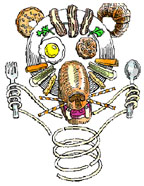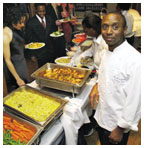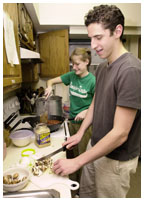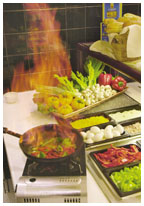April 21, 2004: Features



Once students consumed dry bread and thick coffee. Today: 224,000 cookies
By Brett Tomlinson
Illustrations by Ron
Barrett
Photographs
by Frank Wojciechowski
Princeton students never have been particularly forgiving of their chefs. In the mid-1700s, when students were dissatisfied with their meager suppers of bread, butter, and milk, they would steal into town to fetch chickens to roast over fires in their Nassau Hall chambers. The early Princetonians complained in letters home that the bread was too black or too dry, the coffee too thick, and the butter tasted of onions. To protest, they scraped their feet on the floor under the table, since it was nearly impossible for the tutors who proctored the dining room to trace the noise to the culprit. Once, students took aim at a more specific target, carving a block of butter into a likeness of the steward and hanging it by the neck in the dining hall.
Quadrangle head
chef Neville Sutherland says that special occasions, like the spring
Brown Hall Co-op
members prepare a hearty pasta dinner, with David Matthews ’05
chopping mushrooms and onions while Erin Kappeler ’05 stirs
Lunchtime at
Mathey features Mongolian stir-fry, made to order, and sautéed
|
On nights that refectory meals were truly wretched, students in the 1840s would rise from their seats on a prearranged signal, grab their tablecloths, carry the entire meal to the window, and toss it out to the ground below. Administrators eventually allowed students to leave campus for meals, and they jumped at the opportunity, dining with local families, at boarding houses, and at informal (and later, formal) “eating clubs.” By 1856, the University refectory closed, not to return completely for another 50 years.
The lessons of the past reinforce what Stuart Orefice, the director of University dining services, already knows: “You’re only as good as your last meal.” Today’s dining halls offer extraordinary variety on a daily basis, but even with fresh ingredients and dishes made to order, student eaters can be a finicky bunch. Student tastes have changed and broadened, covering a spectrum of international cuisines, special dietary needs, and personal preferences. Twenty years ago, a salad bar and three entrees, including one vegetarian option, met collegiate dining standards. Now, three options are barely enough to cover the vegetarians. “We have vegans, we have lacto-ovos, we have fruitarians, we have some things I never thought I’d ever hear of,” Orefice says.
As cooks have for generations, the chefs in dining services, the eating clubs, and campus alternatives strive to deliver a little slice of home – of “comfort food,” which would explain the more than 224,000 cookies baked by dining services last year.
Feeding Princeton is not a 24-hour job – it’s more like 23 and a half. The food court at the Frist Campus Center is closed, cleaned, and locked up by 3:30 a.m., and the dining services bakeshop opens at 4. By the time Orefice arrives at 7 a.m., fresh muffins, croissants, and Danish pastries are already on the counters.
Today’s dining hall breakfasts, with their baked sweets, omelet stations, and rows of name-brand cereals, would be incomprehensible to the early occupants of Nassau Hall, who ate in a dining room in the basement, next to the steward’s quarters and the kitchen. Their meals were marked by simplicity and frugality: coffee, bread and butter for breakfast, occasionally with a side of radishes, and pretty much the same for supper. Historian Thomas Wertenbaker wrote in his 1946 book, Princeton 1746—1896, that the noon meal “was more in keeping with the appetites of growing boys – ham, veal, beef or some other meat, with potatoes and fresh vegetables in season, for dessert if any, apple pie or chocolate cake.” But in 1815, the Board of Trustees decided “the style of living in the refectory [was] more luxurious than it ought to be,” and passed a motion to ensure that “in the future no unnecessary expense may be incurred for furnishing the table of the students.”
The revival in 1906 of dining halls – called the Commons – breathed new life into the campus menu. Students could eat everything from eggs and four cereal choices in the morning (two hot and two cold) to steak and fish at the dinner hour. Ice cream, bread, rolls, and biscuits were made on the premises. It was a welcome change from the boarding-house meals of the previous decade, where, according to a January 1907 PAW article, “students had frequently pitched battles, with biscuits, potatoes, and pieces of pie for projectiles, which probably did less harm in this way than as food.”
Today, of course, freshmen and sophomores eat in their residential colleges; the traditional snake-line cafeteria has been replaced with the “marketplace” model, where themed stations and specialty bars offer different dishes. There are fewer walls between the kitchen and the customers, to show that the food is fresh, not reheated, and in some cases, students can get custom entrees, cooked to order. The menu has changed even more than the kitchen setup. Orefice says one of his predecessors, Thomas Root, was at the forefront of that movement, creating a vegetarian dining hall in the 1970s. But early vegetarian options were not always well conceived – chopped spinach and cheese baked in a tray and cut into squares may be easy to make, but it hardly constitutes an entrée.
More recently, low-fat dressings, cottage cheese, frozen yogurt, and cheeses and organic produce have made their way onto the menu, and dining services pays attention to low-carb dieting options, too. Recent additions to the dining services ingredient list include triticale, a protein-rich wheat and rye hybrid, and seitan, also known as “wheat-meat.” There are black bean burgers, organic cereals, and egg-white omelets, plus daily kosher meals at the Center for Jewish Life, and halal meals for Muslim students Thursday evenings at Frist Campus Center. Dietician Susan Pierson and her staff have created an interactive Web site that provides nutritional information, taking into account all 6,000 ingredients used by dining services; students can select the food they ate at a meal and calculate their fat, protein, carbohydrates, caloric intake, and other statistics. Pierson says the site will be particularly helpful for students with diet-related medical conditions. (Because of concerns about students who obsess over their calorie intake, the information is not posted above the platters in the dining halls.)
Health concerns are just part of the equation when stocking the pantry. Dining services orders many items with environmental or political issues in mind. It uses seafood approved by the Sustainable Seafood initiative, fair-trade organic coffee, and, since the fall, an increasing quantity of Jersey Fresh produce. In-state farms harvested 15,000 pounds of produce for the University in the current academic year.
Around 7 p.m. at the Quadrangle Club, the second swell of the dinner crowd makes its way through the buffet. As a member in the line shoots a disappointed glance at the nearly empty tray of steaks, Tyrone Porter turns the corner and swiftly replenishes it with a fresh helping of juicy prime rib, smothered in grilled onions. Porter’s timing puts a smile on the face of Neville Sutherland, Quadrangle’s head chef and steward. That’s the way a kitchen should work, he says, but it’s not as easy as it looks.
Sutherland, a native of Liverpool, went to culinary school, served a tour with the British army’s culinary corps in Germany and Northern Ireland, and traveled the world cooking in the kitchens of hotel restaurants, preparing meals for celebrities such as Michael Jackson and Andrew Lloyd Webber. But when he finally settled into his job at Quadrangle in 1996, he realized that he had not yet seen everything. “Nothing can ever prepare you for the Street,” he says. “You can’t come here with an ego.”
Membership fluctuations mean that dues, and the kitchen jobs they support, are never guaranteed, so developing a cohesive staff is difficult. Eating club members can be demanding, and since they change from year to year, the daily routine never becomes routine. The steward must make the bulk-food orders, but has to remember when a handful of members need a carton of soy milk. Each year, members put a new toy on the wish list – a Slushie mach-ine, a frozen yogurt dispenser, a new soda fountain, a cookie oven, an instant cappuccino maker, a popcorn machine – and each year, Sutherland finds a way to pay for it.
Since their inception in the 1840s, the eating clubs — there are now 11, down from 25 in the 1870s — have tried to outdo University dining halls with impeccable menus, particularly for special events. When William A. Robinson, Class of 1902, donated his Ivy Club artifacts to the University archives, he included a December 8, 1900, menu for Thanksgiving dinner to show “what was considered sufficient food in those days.” Vermont turkey was the main course, but the menu also included chicken, halibut, and all the trimmings, plus desserts. Today’s formal occasions can be just as extravagant, at least in the displays of food on the table, which is a source of pride for Sutherland and his colleagues. “That’s where we really show what we can do,” says the chef. In his office, he keeps a photo scrapbook of the elaborate seafood spreads, fruits, cheeses, and appetizers he has arranged for reunions and formals.
For everyday meals, Sutherland’s budget is more constrained – roughly $8 a day, per member, for three meals. He manages to get value for the money, with a full salad and sandwich bar open all day, fresh-baked bread at every dinner, two meat or fish entrees, a vegetarian option, pasta, two vegetables, and a dessert. After a few down years, Quadrangle’s membership has swelled to capacity, with 270 students, including February’s sophomore signups. Sutherland is happy that the food may have contributed to the club’s resurgence. “We’re all tired,” he says, “but it’s a good kind of tired.”
On Wednesday afternoons at 4:30, Francis Pickering ’04 and his three cooking mates cram into the tiny kitchen on the second floor of Brown Hall. Pickering is not exactly a professional chef, but he does have a knack for finding exotic recipes that work. On this day, he places 12 pounds of frozen lamb into the sink to defrost and opens an aging French cookbook to the recipe for lamb filets with cognac sauce over chestnut puree. As he starts to work on the sauce he poses a question, to no one in particular: “Do you think tarragon vinegar will substitute for tarragon? It smells the same.”
Pickering is one of 24 members in the Brown Co-op, one of two small student-run eating cooperatives on campus. Two Dickinson, the other co-op, concentrates on vegetarian and vegan meals, but the Brown group is distinctly omnivorous. Once a week, each co-op member helps to cook dinner for the entire group. The members help themselves to breakfast and lunch from the pantry, which the members take turns stocking with trips to local grocery and wholesale stores.
The cooperative model, as an alternative to eating clubs, has historical precedent at Princeton. In a May 1903 issue of PAW, a campus news item noted that “a cooperative club has been tried on a small scale this year in Princeton, among members of the junior and senior classes.” The 50 members each paid $4.50 a week for meals, but the group broke up when members began to suspect that the managers were skimming profits for themselves.
A century later, Brown and Two Dickinson charge $600 and $500 per semester, respectively, and the members have checks and balances on spending. The biggest crisis, says former Brown president Brian Skerratt ’04, came when someone stole the wagon co-op members used to cart groceries down Nassau Street. But they have regrouped and recovered, buying a bigger, better wagon, and a bigger, better bicycle lock to secure it.
Cooking for 24 can be as complicated or as simple as you want to make it, Skerratt says. In the Wednesday-night crew, David Matthews ’05 tosses a salad with pine nuts and vegetables, while Skerratt and Erin Kappeler ’05 work carefully on dessert crepes, filled with fruit, Nutella, or honey. Pickering’s job is clearly the hardest. After mixing a sauce of cognac, beef bouillon, tarragon, and copious amounts of butter, he plunges his hands into a mixture of flour and lamb, and then fries the meat thoroughly before serving it on a bed of warm chestnut puree, with the cognac sauce drizzled on top.
As with the eating clubs, food is only part of the draw for co-op life. The co-op offers a community, an adoptive family that cooks with the radio blaring and then turns off the music to converse over dinner. Memorable conversations make the work worthwhile, Skerratt says, even when you set off the smoke alarm, or your casserole flops and forces an impromptu meal of peanut butter and jelly.
Campus cooks agree that to break the monotony, some meals have to go beyond the norm. At Quadrangle, theme nights spice up the members’ palates. Spanish night, for example, features paella, marinated sirloin steak, chicken in an orange Spanish sauce, and natillas (Spanish custard). At Brown Co-op last spring, on the eve of the war in Iraq, Pickering cooked up a quiet war protest by preparing an Iraqi chicken dish that the members still talk about.
For two weeks each year, Orefice invites four-star chefs from New Jersey and Chicago to cook in the dining hall kitchens, and his “No Place Like Home” contest invites students to submit recipes from home for the dining hall menu. Winning recipes are served around campus, and the students’ parents are flown into town to supervise. (Ulla Vilkman, the mother of 2002 contest winner Rosa Poetes ’05, came all the way from Germany to cook her Mediterranean chicken dish.) A truly creative idea tends to wake up even the dining-hall skeptics. In 1998, for example, dining services held “Seinfeld night,” at which students dined on chocolate babka, stromboli, Junior Mints, and other foods mentioned in episodes of the popular sitcom.
University food will always be a tough sell, but in nearly 12 years at Princeton, Orefice has learned that success needn’t come with rave reviews. While few are willing to give dining services a full endorsement, Princeton students rarely go to bed hungry. Says Sarah Dabby ’07, “It’s definitely better than the food at other schools that I’ve visited.” Orefice, whose department won an Ivy Award for excellence from Restaurants and Institutions magazine in 2003, dines with students regularly, collecting complaints, suggestions, and the occasional compliment.
“A lot of times I’ll hear, ‘You know, the food’s
not that bad here,’” he says. “I’ll take that.”
![]()
Brett Tomlinson is an associate editor at PAW.
Great moments in Princeton dining

1756 Nassau Hall is completed, with a kitchen and student dining room in the basement. Rules decreed that “none shall eagerly catch at a share, but wait till he is served in turn,” according to Alexander Leitch ’24’s “A Princeton Companion.”
1803 Dining facilities move to a separate building, the Refectory (later called Philo-sophical Hall). The noon meal is the most substantial of the day, with meat, potatoes, vegetables, and desserts. Breakfast and supper consist of bread, butter, and coffee or milk.
1843 Students, distraught at the price and quality of Refectory food, receive permission to take their meals with families in town. Within a few years, the students form the University’s first eating clubs.
1856 The Refectory closes, unable to keep up with the growing allure of eating off campus.
1877 The first revival of the dining hall system fails.
1892 At the inaugural dinner of the University Club, students dine on consommé Italienne, filet of striped bass, filet of beef, spaghetti Napolitane, ribs of beef, Vermont turkey, mashed potatoes, green peas, mashed turnips, and for dessert, apple pie and soufflé of rice.
1906 The University creates “freshman eating clubs,” a new dining system at University Hall that a PAW article says is designed “to give the freshmen good food, properly served, under healthful and comfortable conditions.”
1916 Two of the five dining halls at Madison Hall are opened.
1943 The University announces its first catering contract with Howard Johnson’s.
1960 The University establishes its own food services department after ending its contract with Howard Johnson’s.
1972 Kosher dining begins at Stevenson Hall. Meanwhile, the Sub-Eagle dining hall in Madison Hall is “devoted exclusively to serving natural foods and vegetarian dishes,” according to an article in the “Princeton Packet.”
2000 The Frist Campus Center opens, bringing a food court to the center of campus.
![]()



